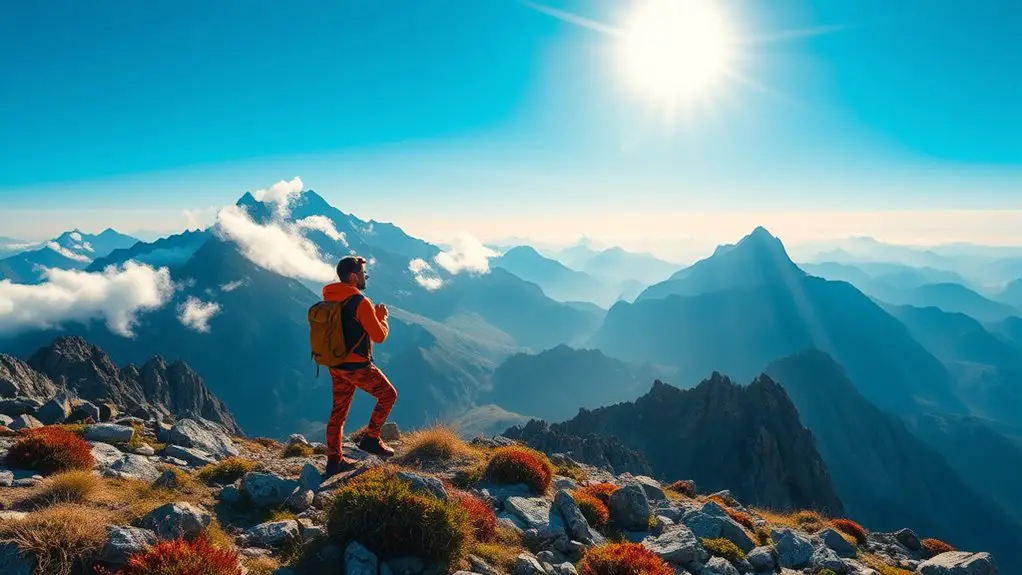To train your lungs for high-altitude trekking, focus on breathing exercises like diaphragmatic and pursed lip breathing to maximize oxygen intake. Incorporate cardiovascular workouts such as running or cycling to strengthen lung capacity and endurance. Don't forget interval training to enhance your stamina and adapt to exertion demands. Stay hydrated and follow nutrition guidelines for lung health. Monitoring your progress helps adjust your training. There's more to explore on effective training strategies for a successful trek!
Understanding Altitude and Its Effects on Breathing
When you're trekking at high altitudes, your body faces unique challenges, especially regarding breathing. The air gets thinner as you climb, meaning there's less oxygen available. You might feel short of breath, even with minimal exertion, which can be frustrating when you're seeking that sense of freedom in nature. It's important to understand that this doesn't mean you're unfit; it's simply a response to the changing environment.
Your body needs time to acclimatize, adjusting to lower oxygen levels. You'll likely notice that your heart rate increases, working harder to circulate oxygen. This makes it vital to pace yourself and listen to your body. Embracing a slower rhythm can actually enhance your experience, allowing you to soak in the stunning views while your lungs adapt. By recognizing these effects, you can better prepare for the exhilaration of high-altitude trekking and enjoy the adventure that lies ahead.
Importance of Lung Capacity for High-Altitude Trekking
As you acclimatize to high altitudes, having a strong lung capacity becomes increasingly important for your trekking experience. With thinner air, every breath counts, and your body needs all the oxygen it can get. A well-developed lung capacity means you can take in more oxygen with each inhale, helping to fuel your muscles and keep your energy levels up.
When you're hiking in breathtaking landscapes, the last thing you want is to feel winded or fatigued. Good lung capacity enhances your endurance, allowing you to tackle challenging trails with confidence. It also helps minimize the risk of altitude sickness, letting you fully embrace the freedom of exploration.
Breathing Exercises to Enhance Lung Function
To improve your lung function for high-altitude trekking, it is crucial to incorporate specific breathing exercises. Techniques like diaphragmatic breathing and pursed lip breathing can help you maximize oxygen intake and control your breath. By practicing these methods regularly, you'll strengthen your lungs and enhance your performance on the trails.
Diaphragmatic Breathing Techniques
Although many people breathe without thinking, mastering diaphragmatic breathing can greatly enhance your lung function, especially for high-altitude trekking. This technique involves using your diaphragm, allowing your lungs to fill more completely. To practice, sit or lie down comfortably. Place one hand on your chest and the other on your abdomen. Inhale deeply through your nose, letting your stomach rise while keeping your chest still. Exhale slowly through your mouth, feeling your abdomen fall. Aim for five to ten minutes daily, gradually increasing your duration. This focused breathing not only improves oxygen intake but also promotes relaxation, giving you the freedom to tackle those challenging trails with confidence. Embrace the journey and let your breath carry you forward!
Pursed Lip Breathing
Pursed lip breathing is a simple yet effective technique that can greatly enhance your lung function, especially during high-altitude trekking. This method helps you control your breath, making it easier to take in oxygen and exhale carbon dioxide. Here's how you can practice it:
| Steps | Description |
|---|---|
| Inhale | Breathe in slowly through your nose. |
| Purse your lips | Form your lips as if you're going to whistle. |
| Exhale | Exhale slowly through pursed lips, taking twice as long as your inhale. |
| Repeat | Practice for 5-10 minutes daily. |
| Focus | Concentrate on your breathing rhythm. |
Cardiovascular Training for Stronger Lungs
To build stronger lungs for high-altitude trekking, you'll want to focus on cardiovascular training. Aerobic exercises boost your endurance, while specific breathing techniques can help you use oxygen more efficiently. Together, these practices will prepare your lungs to handle the challenges of higher elevations. Incorporating high-intensity interval training can further enhance your lung capacity and overall endurance.
Aerobic Exercises for Endurance
Aerobic exercises play an essential role in building endurance and enhancing lung capacity, making them crucial for high-altitude trekking. Incorporating these activities into your routine will help you breathe easier and go further. Here are four great aerobic exercises to evaluate:
- Running: Feel the wind against your face as you hit the pavement, pushing your limits with every stride.
- Cycling: Glide through scenic trails, feeling the freedom as you pedal your way to better endurance.
- Swimming: Immerse yourself in cool water, finding rhythm and flow while strengthening your lungs.
- Dancing: Let loose and move to the music, elevating your heart rate while having a blast.
These exercises will prepare you for the heights ahead, ensuring you can explore the great outdoors with confidence.
Breathing Techniques for Efficiency
While you're training for high-altitude trekking, mastering effective breathing techniques can greatly enhance your lung efficiency. Start by practicing diaphragmatic breathing, where you engage your diaphragm fully, allowing deeper breaths. Inhale through your nose, expanding your belly, then exhale through your mouth, emptying your lungs completely. This method maximizes oxygen intake and keeps you relaxed.
Incorporate box breathing, too: inhale for four counts, hold for four, exhale for four, and hold again for four. This technique not only improves lung capacity but also calms your mind.
Lastly, practice rhythmic breathing while walking or running. Sync your breath with your steps—inhale for three strides, exhale for two. This approach helps maintain stamina and keeps your body in sync with nature's rhythm.
Incorporating Interval Training for Endurance
Since you'll be facing the challenges of high-altitude trekking, incorporating interval training into your routine can greatly enhance your endurance. This method pushes your limits and prepares your lungs for the thin air above. Here's how to get started:
- Sprint Intervals: Alternate between short bursts of sprinting and recovery jogs to build cardiovascular strength.
- Hill Repeats: Find a steep hill and run up it several times, allowing your body to adapt to increased exertion.
- Circuit Workouts: Combine exercises like burpees, jump squats, and mountain climbers with short rest periods to develop explosive strength and stamina.
- Fartlek Runs: Mix up your pace during a run, alternating between fast and slow segments to boost your overall endurance. Additionally, incorporating high-intensity interval training can lead to improved mental toughness and resilience during your treks.
Utilizing Diaphragmatic Breathing Techniques
Diaphragmatic breathing techniques can greatly improve your lung capacity and efficiency, which is essential for high-altitude trekking. By engaging your diaphragm, you'll fill your lungs more completely, allowing for deeper, more effective breaths. Start by finding a comfortable position, either sitting or lying down. Place one hand on your chest and the other on your belly. As you inhale deeply through your nose, focus on expanding your belly rather than your chest. This means you're using your diaphragm properly. Exhale slowly through your mouth, feeling your belly contract. Practice this technique for 5-10 minutes daily. As you grow more comfortable, incorporate it into your physical activities, such as hiking or running. You'll notice increased stamina and reduced fatigue, giving you the freedom to explore the heights you've always dreamed of. Embrace this powerful technique, and your lungs will thank you as you trek through those breathtaking landscapes.
Acclimatization Strategies for High Altitudes
Acclimatization is essential for anyone venturing into high-altitude environments, as it helps your body adjust to lower oxygen levels. To embrace the freedom of the mountains, you need to give yourself time to adapt. Here are four key strategies to help you acclimatize effectively:
- Gradual Ascent: Increase your altitude slowly, aiming for no more than 1,000 feet per day above 8,000 feet.
- Rest Days: Take breaks to allow your body to adjust; consider spending extra nights at certain elevations.
- Listen to Your Body: Be aware of symptoms like headaches or dizziness—these might be signs to descend.
- Stay Active: Gentle exercise can stimulate circulation and oxygen flow, enhancing your body's adaptation process.
Nutrition and Hydration for Optimal Lung Health
While trekking at high altitudes, what you eat and drink can greatly impact your lung health and overall performance. To guarantee your body gets the nutrients it needs, focus on a balanced diet rich in whole foods. Incorporate plenty of fruits and vegetables, which are high in antioxidants, to support your lungs and combat oxidative stress. Complex carbohydrates, like whole grains, provide sustained energy for your adventures.
Hydration is equally vital. Drink plenty of water to keep your lungs moist and functioning effectively. Dehydration can lead to fatigue and decreased performance, so aim for at least two to three liters daily, adjusting based on your activity level. Consider electrolyte-rich drinks to replenish lost minerals.
Ultimately, fueling your body with the right nutrition and staying hydrated will not only enhance your lung capacity but also empower you to embrace the freedom of the great outdoors.
Monitoring Your Progress and Adjusting Your Training
To guarantee your lung training is effective, it's crucial to monitor your progress regularly and adjust your routines as needed. Embrace your journey to the peaks by paying attention to key indicators of improvement. Here's how you can track your progress:
Regularly track your lung training progress to ensure effectiveness and embrace your journey to peak performance.
- Breathing Tests: Measure your breath capacity weekly; deeper breaths mean stronger lungs.
- Endurance Levels: Track how long you can sustain physical activities without gasping for air.
- Heart Rate Recovery: Notice how quickly your heart rate returns to normal after exercise—faster recovery indicates better lung efficiency.
- Altitude Simulation: Use altitude masks or apps to practice; monitor how your body adapts over time. Additionally, staying hydrated as an athlete is essential for overall performance, including lung function during training.
Frequently Asked Questions
How Does High Altitude Affect My Overall Physical Performance?
High altitude's like running in a dream—your body craves oxygen, making each movement feel heavier. You'll notice decreased stamina, shorter breath, and a struggle to perform, but with adaptation, you'll reclaim your freedom.
Can Yoga Improve Lung Capacity for Trekking?
Yes, yoga can improve your lung capacity for trekking. It enhances breath control, increases flexibility, and strengthens your diaphragm. Practicing regularly will help you feel more liberated and prepared for those high-altitude adventures you crave.
What Are the Signs of Altitude Sickness?
Did you know nearly 25% of those ascending above 8,000 feet experience altitude sickness? If you're feeling headaches, dizziness, or nausea, it's time to descend. Your adventure shouldn't come at the cost of your health!
Should I Use Supplemental Oxygen While Trekking?
Using supplemental oxygen while trekking can help you acclimatize better and improve performance. However, it's not always necessary. Listen to your body, and if you're struggling, consider it for a safer experience in high altitudes.
How Can I Prevent Dehydration at High Altitudes?
Oh sure, who needs water, right? To prevent dehydration at high altitudes, just drink plenty of fluids, eat hydrating foods, and avoid alcohol. Your body will thank you when it's not shriveling up!




